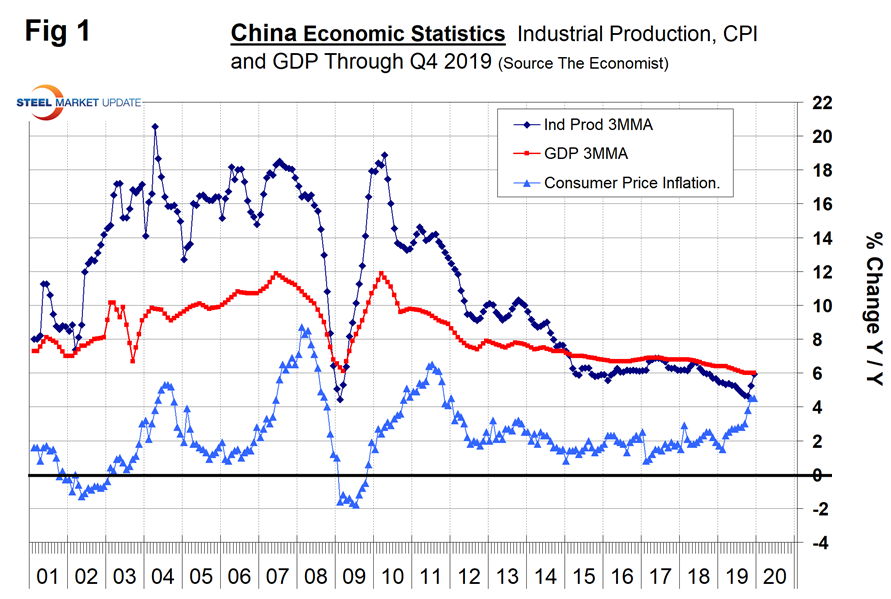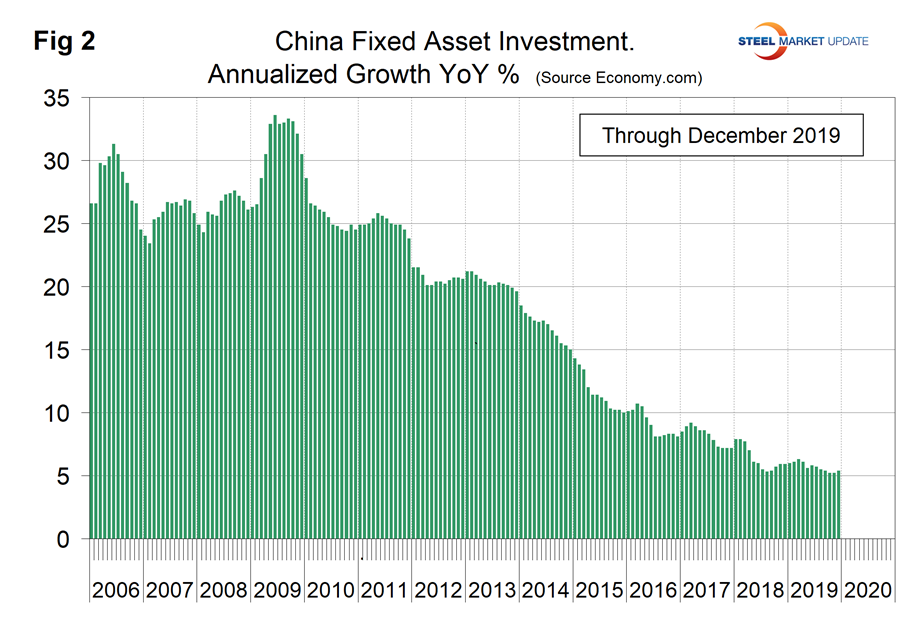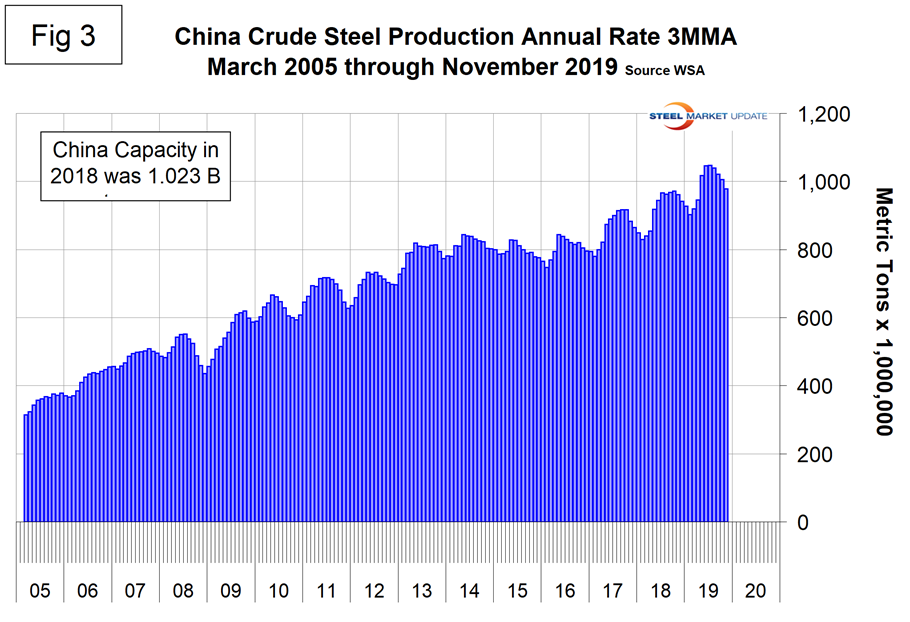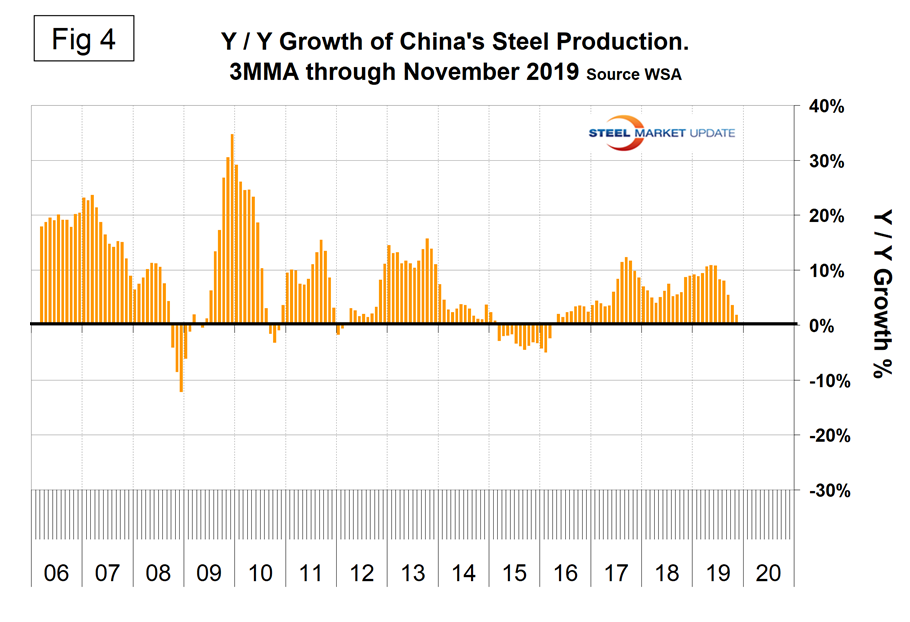Economy

China's GDP Slows, But Should Get Boost from Trade Deal
Written by Peter Wright
January 17, 2020
The official economic statistics out of China show a decline in GDP to a level slightly lower than the depths of the global recession in 2009. China’s share of global steel production was 54.3 percent in November.
Once each quarter we publish the official statistics for Chinese GDP, industrial production, consumer price inflation and fixed asset investment. We don’t know the accuracy of these numbers, but we include them in our reports because of the importance of China in the global steel scene. China’s economic statistics are never revised, which makes analysts suspicious considering the U.S. routinely makes revisions back decades. China’s birth rate fell to its lowest level in 2019 (at 10.48 per thousand) since the founding of the People’s Republic of China 70 years ago, posing a long-term demographic challenge for its government.
Figure 1 shows published data for the fourth quarter of 2019. The GDP and industrial production portions of this graph are three-month moving averages. China’s GDP grew at a rate of 6.0 percent in both the third and fourth quarters of 2019, down from 6.8 percent in the first quarter of 2018. Growth has gradually slowed from 9.7 percent in the first quarter of 2011. China’s industrial production gained 6.9 percent year over year in December, up from 6.2 percent in November and 4.7 percent in October. The first phase of the trade deal between China and the U.S. is expected to provide a boost in activity and investment across China’s industries.

On Jan 16, Xiao Chun Xu, an analyst with Economy.com, wrote: “The Chinese economy maintained its growth at 6% in the fourth quarter, unchanged from the historically low rate in the previous quarter. This was broadly within our expectations as the Chinese economy faced headwinds from both external demand, from the trade war and slowdown of global demand, and internal demand, especially relating to investment. The Phase One trade deal allows China to dodge further tariffs, which should meaningfully settle investor risk aversion and boost the economy in the first half of 2020. However, the threat of a re-escalation still looms, and incentivizing Chinese authorities to uphold agreements made in the deal.”
Figure 2 shows the growth of fixed asset investment year over year. Growth was 5.4 percent, which results in a doubling of investment in 13.3 years.
On Jan. 16, Moody’s Analytics wrote: “Fixed asset investment in China grew by 5.4% year over year in December, a marginal improvement from November’s 5.2% increase. Similar to previous months, growth was spurred mainly by the mining industry, while agriculture and manufacturing stayed soft. Manufacturing was driven by increases in electronic products (16.8%), special equipment manufacturing (9.7%) and pharmaceuticals (8.4%).”

Figure 3 shows the 3MMA of China’s crude steel production through November when it accounted for 54.3 percent of global production.

Figure 4 shows the year-over-year growth of China’s steel production. Growth slowed every month on June through November, but is still positive as the rest of the world slid into contraction in October and November.


Peter Wright
Read more from Peter WrightLatest in Economy

Industry groups praise Senate for passing tax and budget bill
The Steel Manufacturers Association and the American Iron and Steel Institute applauded the tax provisions included in the Senate's tax and budget reconciliation bill.

Chicago PMI dips 0.1 points in June
The Chicago Purchasing Managers Index (PMI) slipped 0.1 points to 40.4 points, in June.

Multi-family pullback drives housing starts to 5-year low in May
US housing starts tumbled in May to a five-year low, according to figures recently released by the US Census Bureau.

Architecture firms still struggling, ABI data shows
Architecture firms reported a modest improvement in billings through May, yet business conditions remained soft, according to the latest Architecture Billings Index (ABI) release from the American Institute of Architects (AIA) and Deltek.

Manufacturing in New York state contracts again
However, companies are growing more optimistic about the future.
